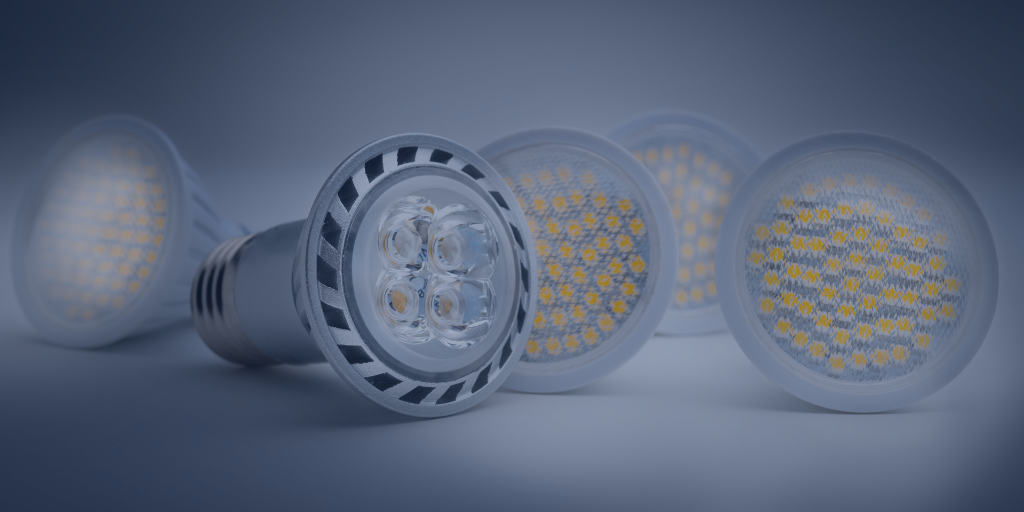Chip-on-board light-emitting diodes (COB LEDs) are at the cutting edge of LED technology.
Manufacturers of lighting systems for residential, commercial, and industrial use have widely integrated chip-on-board LEDs into their products, pushing the market toward growth of almost 12% over the next decade.
What makes chip-on-board LEDs different?
LEDs come in all shapes and sizes, but there are a few standardized “packaging” designs. These packages protect the fragile diodes from the environment while making them easier to incorporate into various applications.
Today, the two predominant types of packaging are surface-mount devices (SMD) and chip-on-board light-emitting diodes. The older SMD design packages each individual diode before soldering it to a printed circuit board.
Chip-on-board LEDs, on the other hand, are mounted directly onto a ceramic or metal substrate. Since the individual diodes are not traditionally packaged, they can be mounted closer together so they take up less space and function as a single lighting panel rather than separate lights. As a result, chip-on-board LEDs tend to be smaller and produce more powerful, concentrated light than their SMD counterparts.
What advantages do chip-on-board LEDs offer?
Like SMDs, COB LEDs have longer lifespans and are more efficient than older light sources like fluorescent bulbs. However, the newer chip-on-board design is the most advanced LED technology and offers several advantages.
Efficiency
Because chip-on-board light-emitting diodes can pack diodes much closer together, they offer greater light output per unit area and a more efficient use of space. For example, the COB package design can fit over 300 diodes into a 10mm x 10mm square. The older SMD design can fit 40 diodes into the same space; its predecessor, the DIP design, can fit only nine. Thus, a chip-on-board LED can be much brighter without sacrificing size or weight.
This also means a chip-on-board light-emitting diode will be many times smaller and require far less energy than an SMD LED with the same lumen output, making COB LEDs a potential game-changer in the push for sustainability. For outdoor applications where lights must be operated by battery, lighting engineers have historically faced a trade-off between a light’s lumen output and runtime. The brighter the light, the less time it can operate on a single battery charge. But thanks to their significant increase in efficiency, chip-on-board LEDs can produce extremely bright light on very low wattage, allowing them to run on a small, lightweight battery for a long period of time.
Durability
Another advantage of chip-on-board light-emitting diodes is that they incorporate fewer components than their predecessors. To produce the same amount of light as a COB LED, you would need several SMD LEDs, each with its own circuitry. Chip-on-board LEDs use only one circuit to power all of their diodes, and with fewer components, they are less prone to failure.
Fewer components also translates to less heat generated. When coupled with an external heat sink, the ceramic or metal substrate of a chip-on-board LED transfers heat more efficiently than the circuit board material of an SMD LED. As a result, chip-on-board LEDs operate at a lower temperature than their SMD counterparts. Between their lower temperature and reduced failure rate, chip-on-board light-emitting diodes tend to be more durable and have longer lifespans than SMDs.
Uniformity
Because COB LEDs can be attached directly to the substrate, they don’t require the traditional diode package used in the SMD design. This package includes additional components like lenses, which contribute to light loss. Without these components, COB LEDs minimize light loss and increase the viewing angle. This gives them a wider beam angle, which provides more uniform lighting over a larger area.
What are the applications of chip-on-board LEDs?
Because chip-on-board light-emitting diodes are so powerful, they are in high demand for many exterior and security lighting applications. Their wide beam and uniform light distribution make them ideal for lighting high bays, mining sites, factories, and warehouses. They are also becoming popular in residential lighting—think ceiling lights and lighted vanity mirrors—as well as niche applications like photography.
Agriculture and horticulture are two of the leading applications of chip-on-board LEDs. With arable land becoming increasingly scarce, farms must maximize their crop output, and creative solutions like indoor and vertical farming must be expanded. Grow lights are key to helping farmers grow plants indoors and improve crop production outdoors. As the population continues to grow and demand more food, the global grow light market is expected to increase at a rate of nearly 15% per year until 2030.
But as with any type of electronics, the chip-on-board light-emitting diode market is prone to unexpected ups and downs. If demand for COB LEDs outpaces production, a shortage could occur. The market could also be negatively impacted by events like pandemics, wars, and natural disasters. A trusted global sourcing partner can help your company predict market conditions, prepare for unexpected shifts, and ultimately weather the storm.
Read more:
● Crisis on the Horizon? Global Energy Crunch and the Electronic Components Supply Chain
● The Growing Push For Sustainability In The Electronics Supply Chain
● Get Exactly What You Need Through a Trusted Global Sourcing Partner

